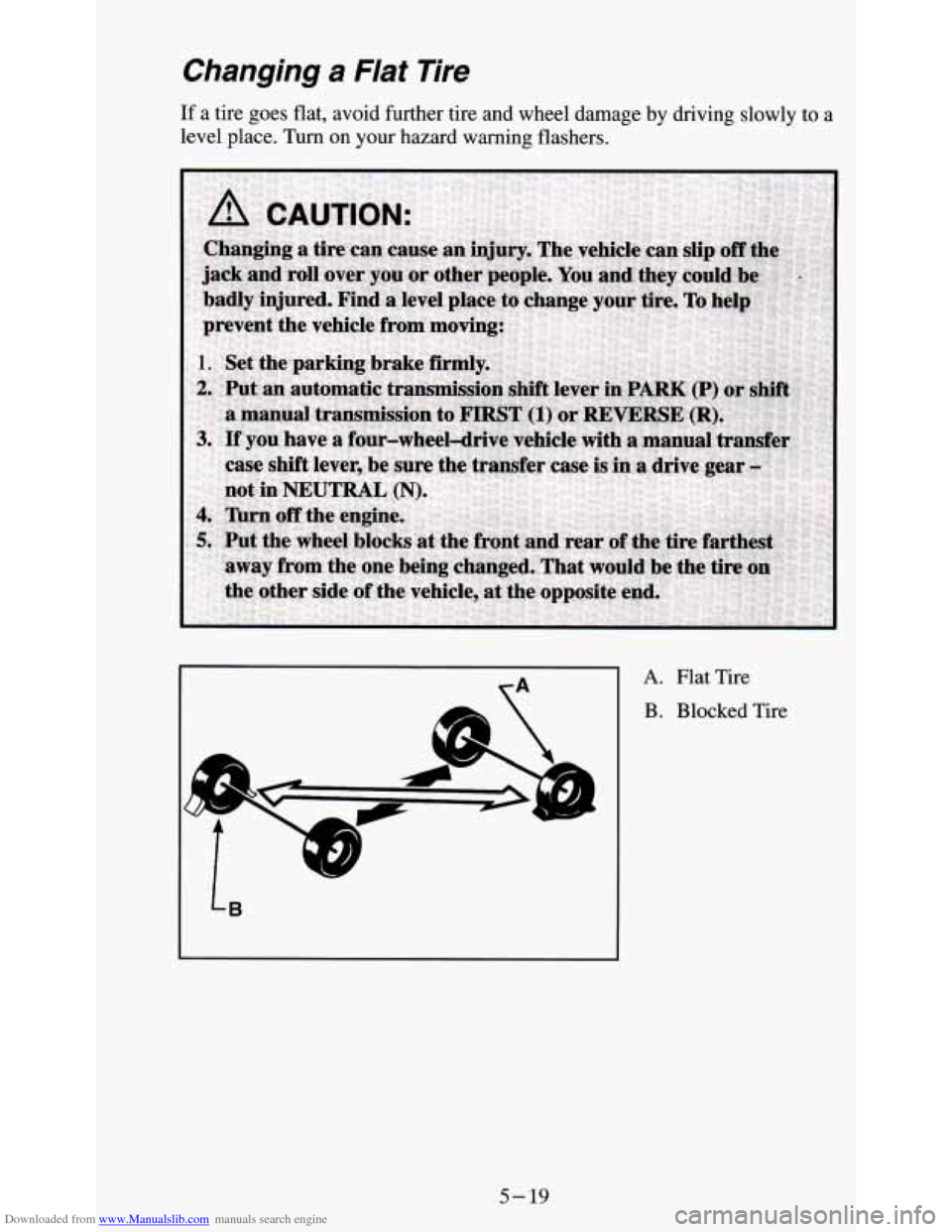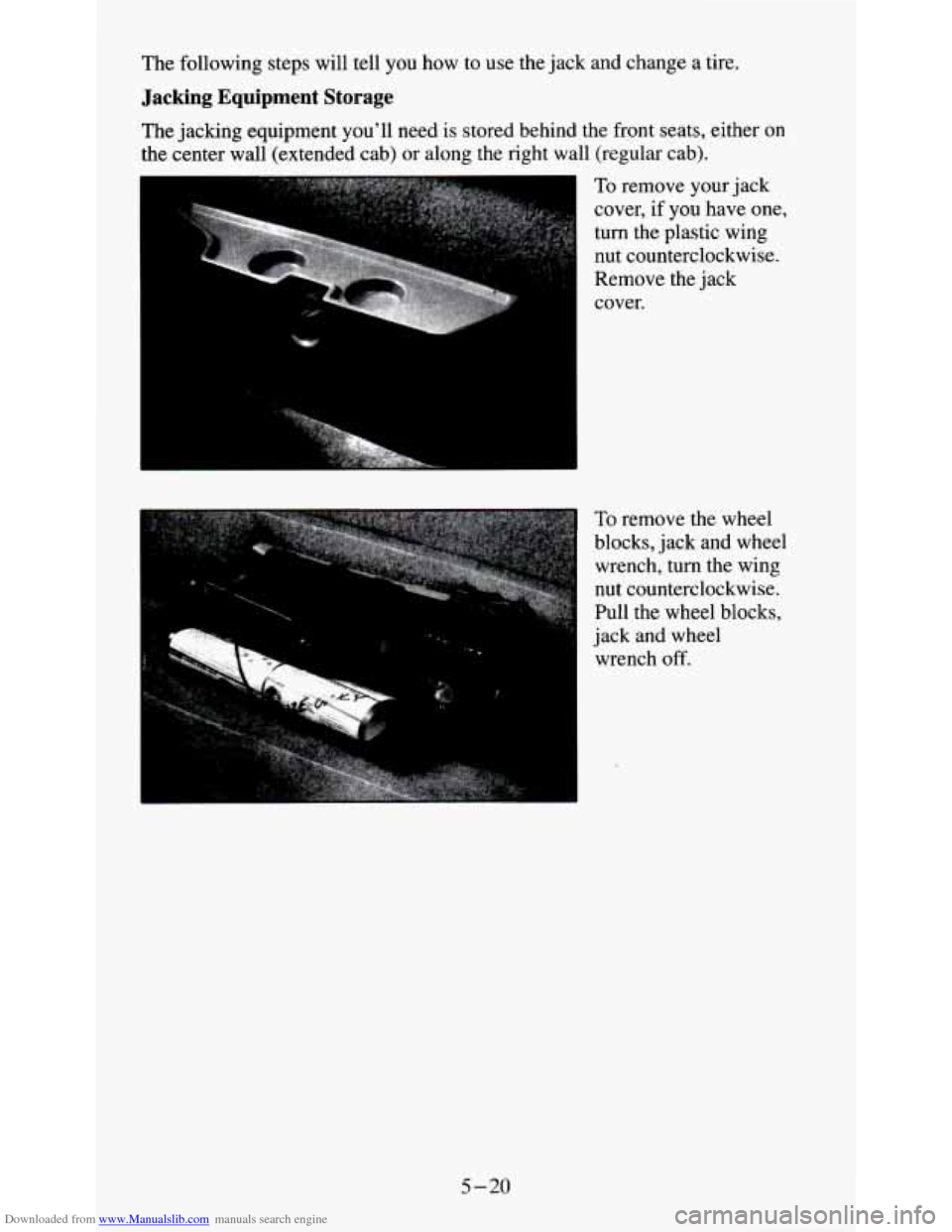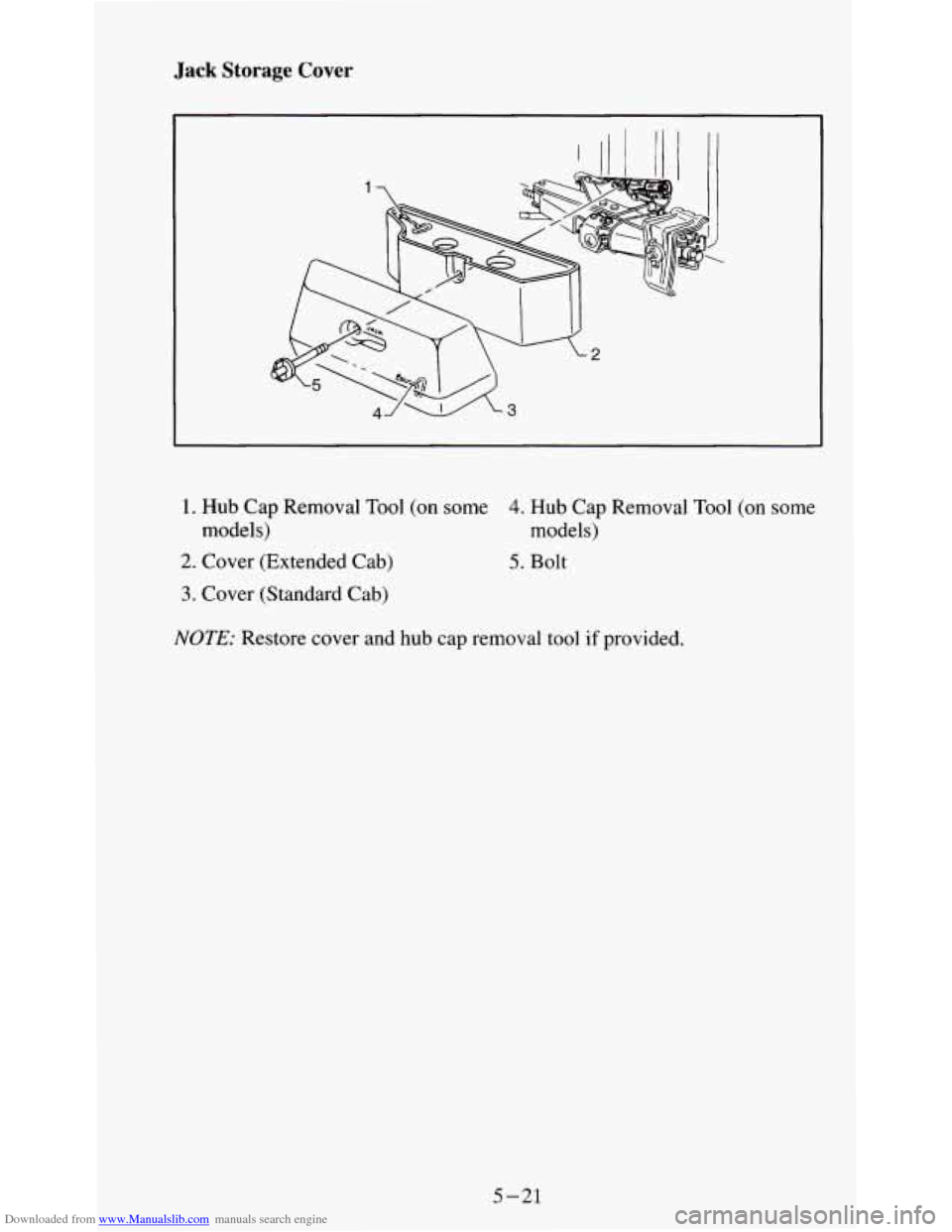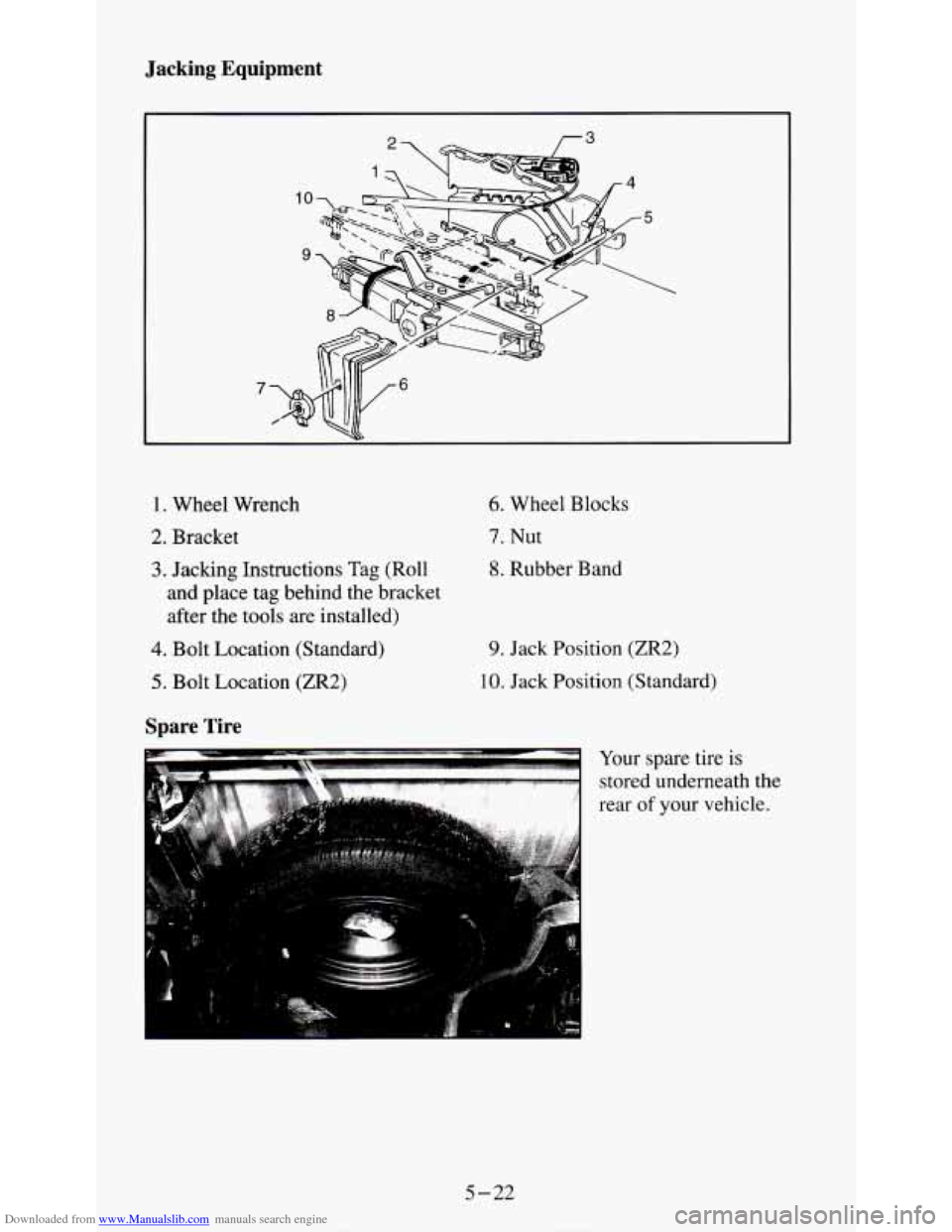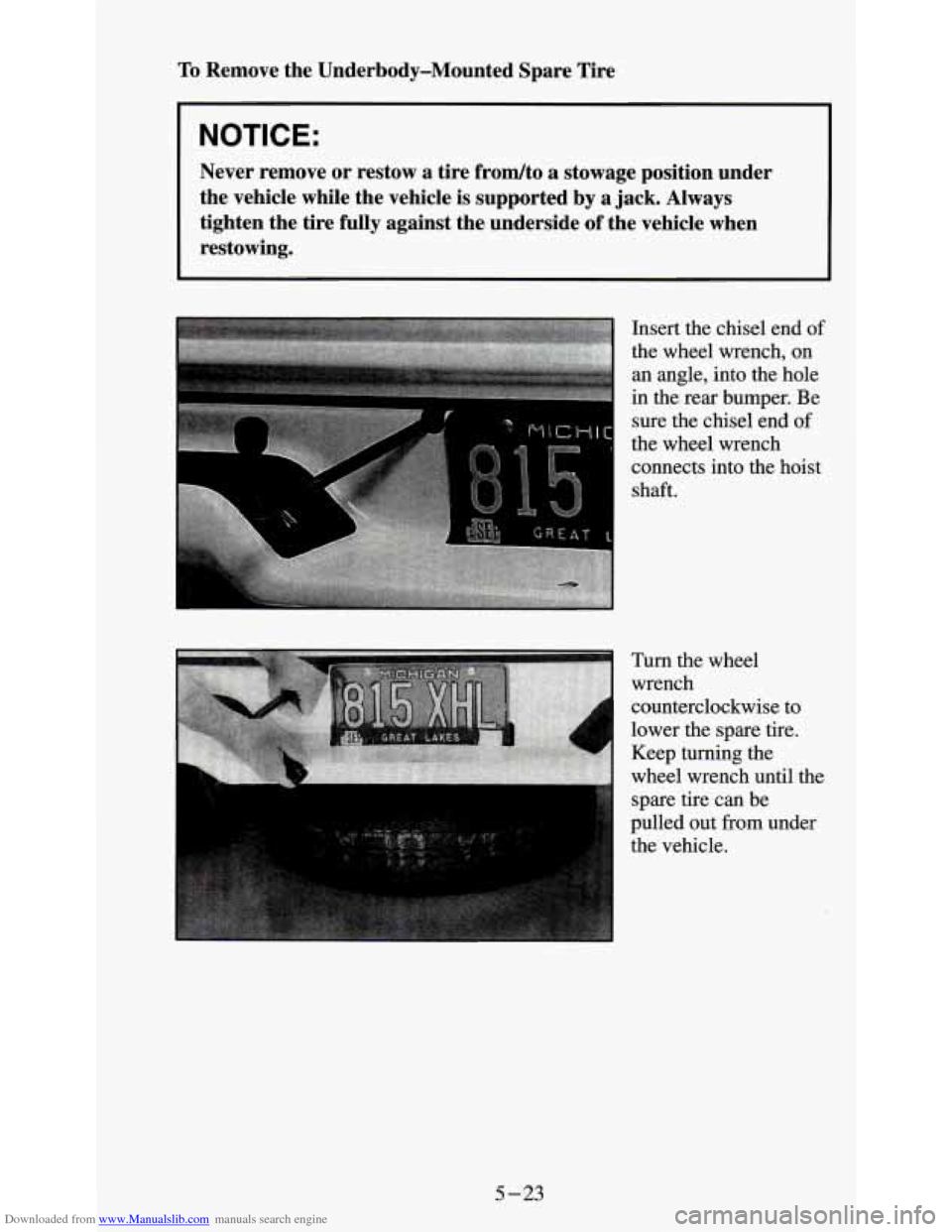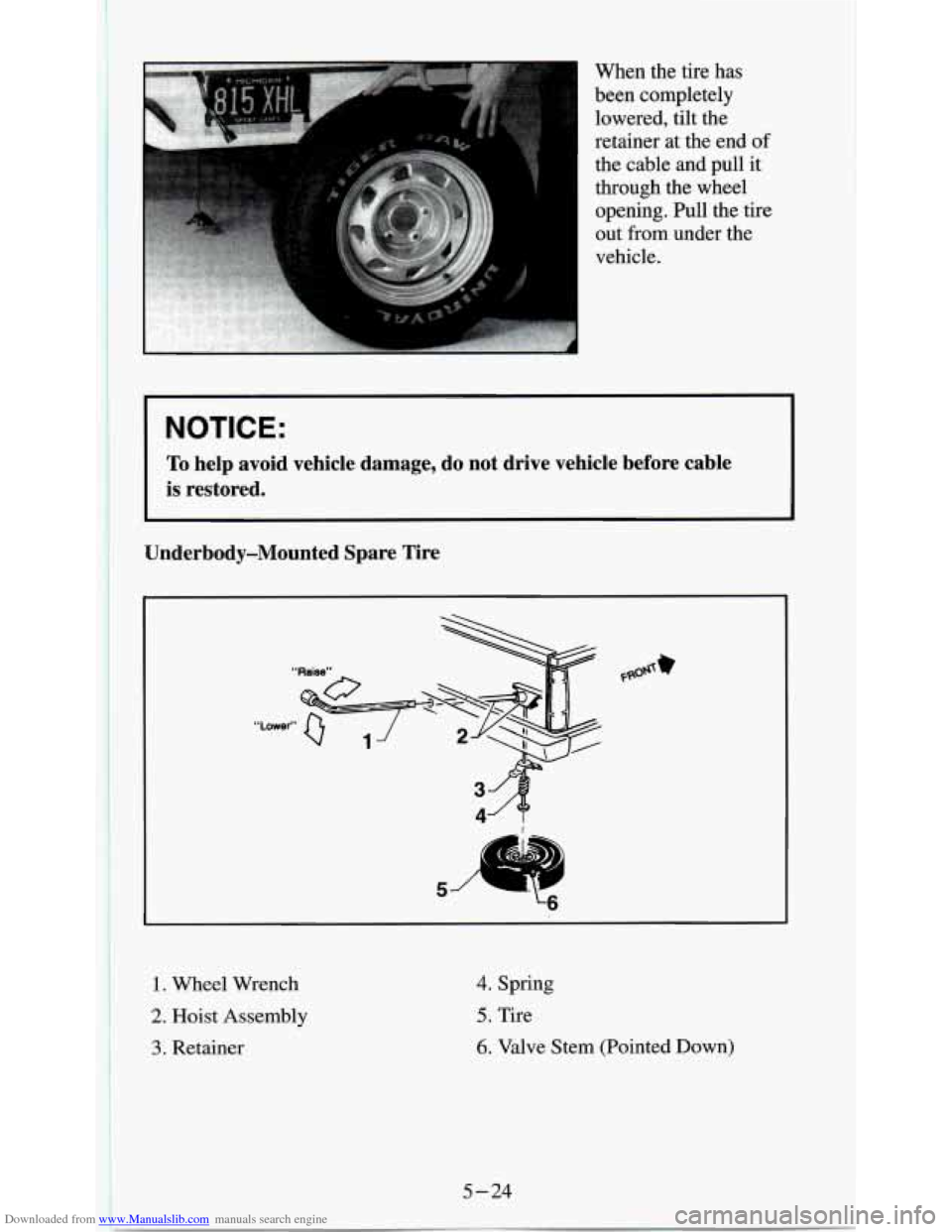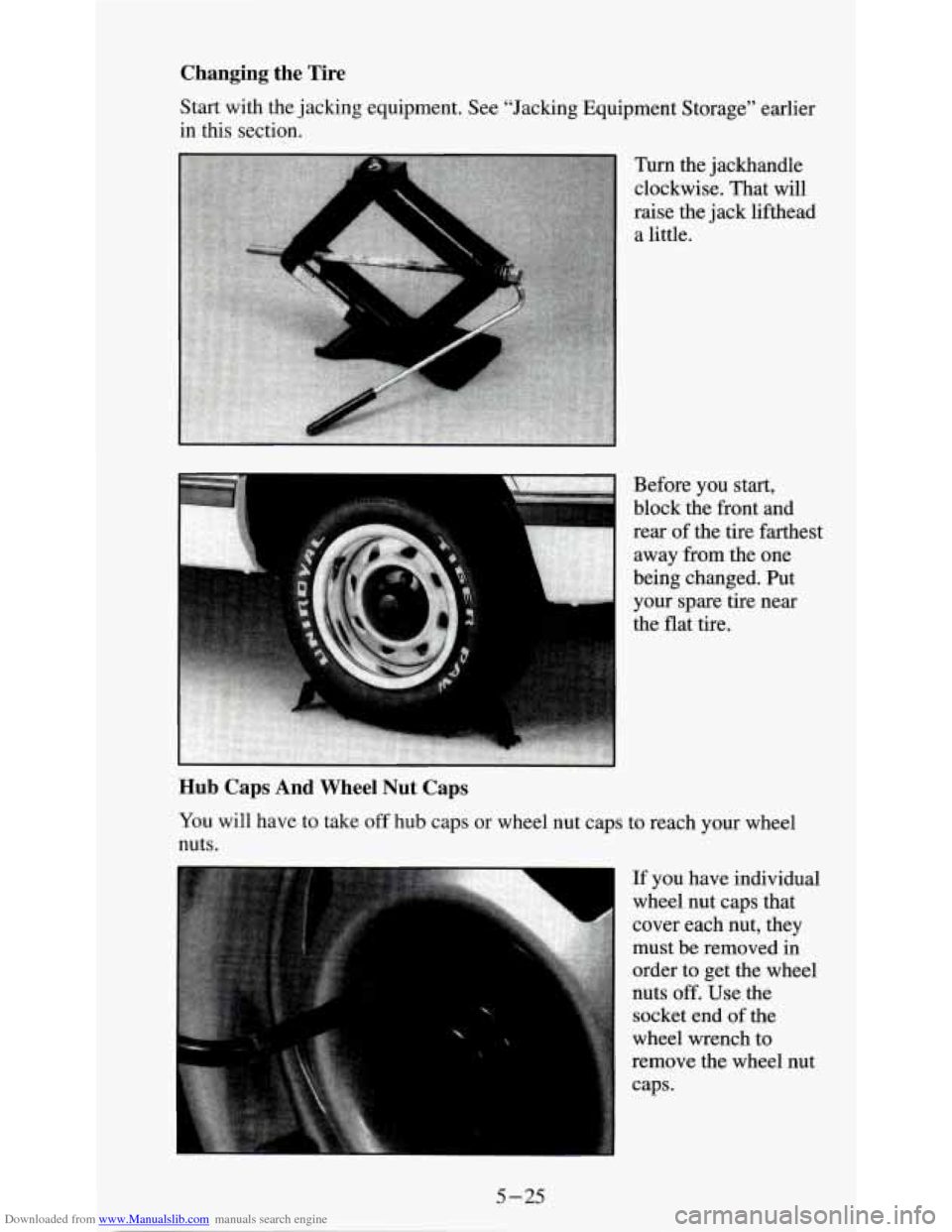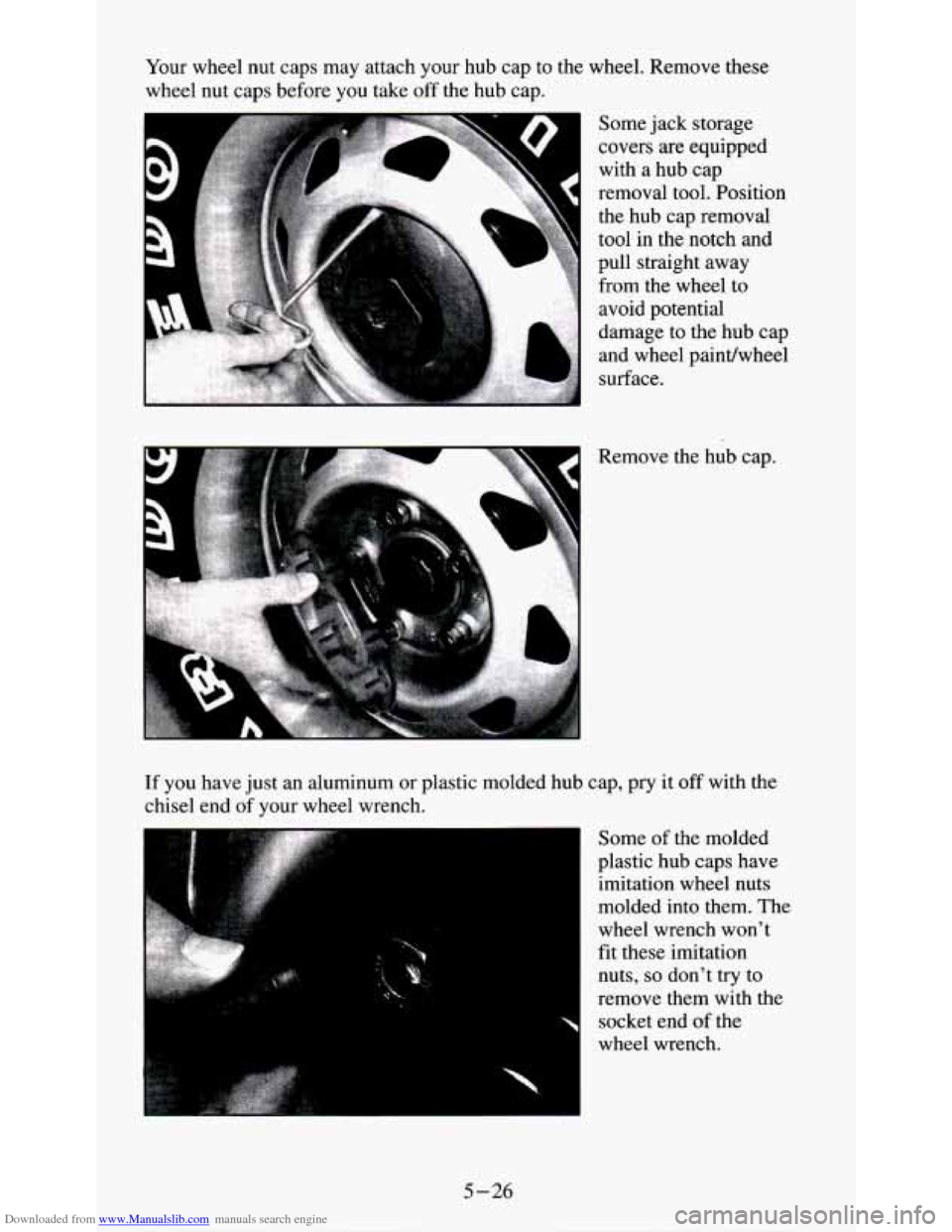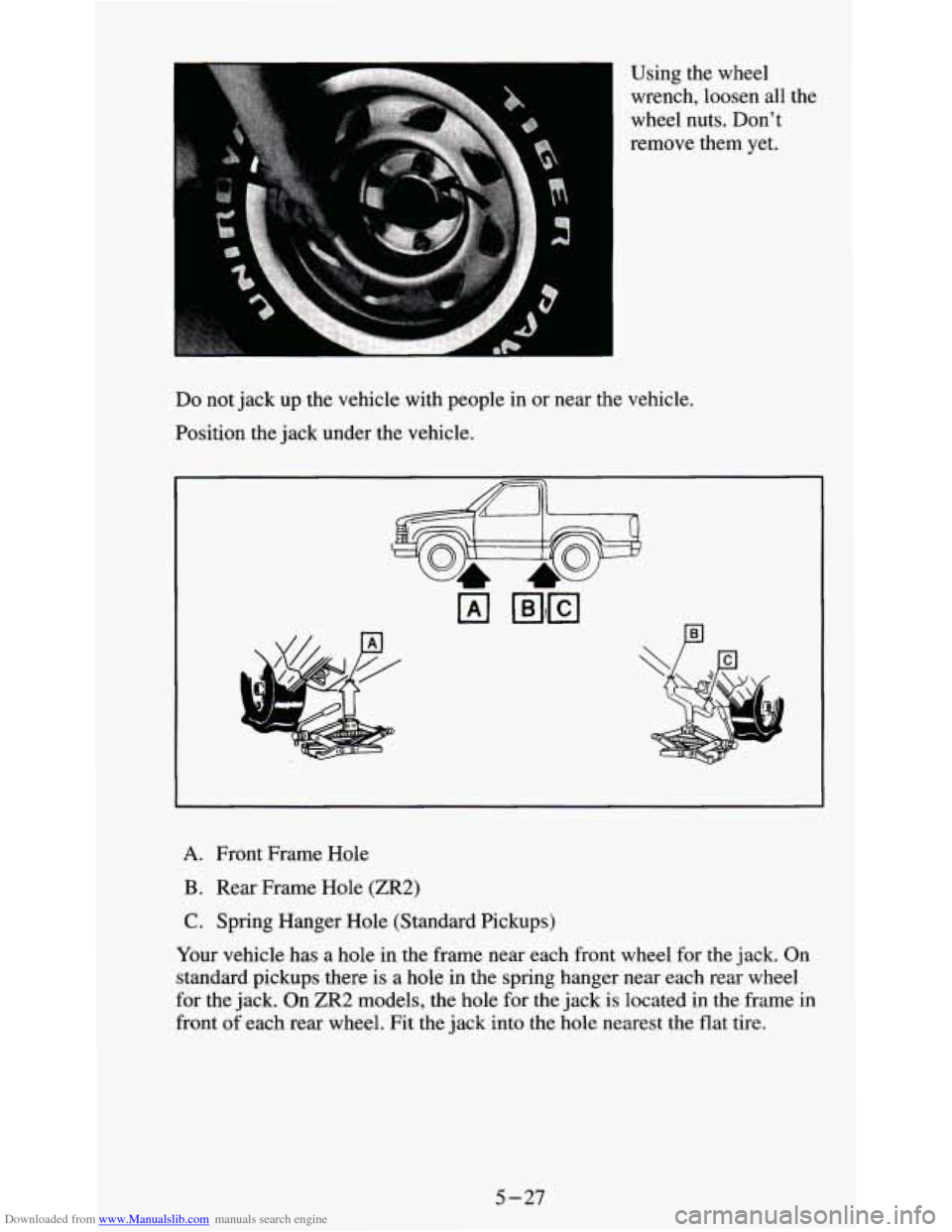CHEVROLET S10 1995 2.G Owners Manual
S10 1995 2.G
CHEVROLET
CHEVROLET
https://www.carmanualsonline.info/img/24/8267/w960_8267-0.png
CHEVROLET S10 1995 2.G Owners Manual
Trending: maintenance, CD player, clock reset, ECO mode, high beam, ground clearance, remove seats
Page 201 of 354
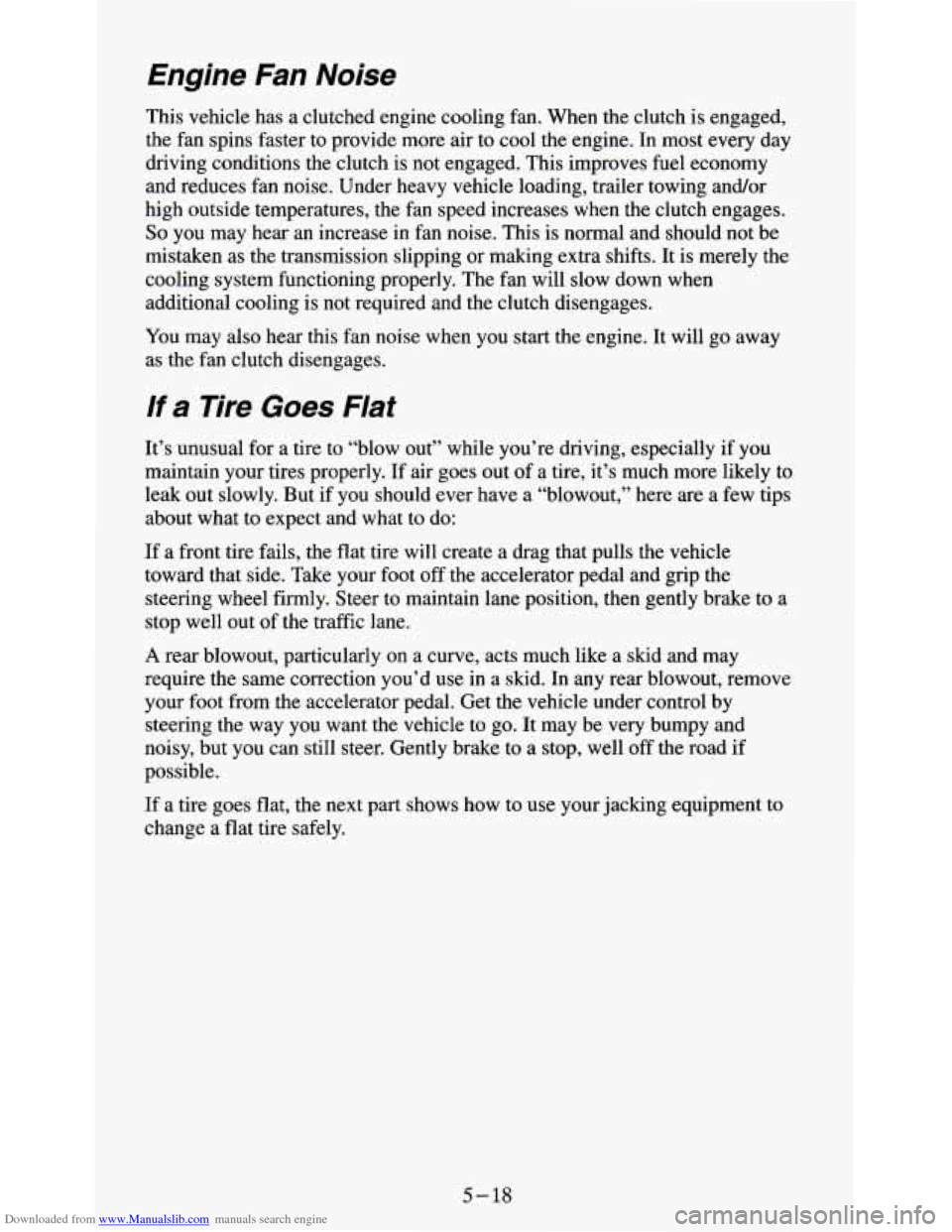
Downloaded from www.Manualslib.com manuals search engine Engine Fan Noise
This vehicle has a clutched engine cooling fan. When the clutch is engaged,
the fan spins faster to provide more air to cool the engine. In most every day
driving conditions the clutch is not engaged. This improves fuel economy
and reduces fan noise. Under heavy vehicle loading, trailer towing and/or
high outside temperatures, the fan speed increases when
the clutch engages.
So you may hear an increase in fan noise. This is normal and should not be
mistaken as the transmission slipping or making extra shifts. It is merely the
cooling system functioning properly. The fan will slow down when
additional cooling is not required and the clutch disengages.
You may also hear this fan noise when you start the engine. It will go away
as the fan clutch disengages.
if a Tire Goes Flat
It’s unusual for a tire to “blow out” while you’re driving, especially if you
maintain your tires properly. If air goes out of
a tire, it’s much more likely to
leak out slowly. But if you should ever have a “blowout,” here are a few tips
about what to expect and
what to do:
If a front tire fails, the flat tire
will create a drag that pulls the vehicle
toward that side. Take your foot off the accelerator pedal and grip the
steering wheel firmly. Steer to maintain lane position, then gently brake to a
stop well out of the traffic lane.
A rear blowout, particularly on a curve, acts much like a skid and may
require the same correction you’d use in a skid. In any rear blowout, remove
your foot from
the accelerator pedal. Get the vehicle under control by
steering the way you want the vehicle to go. It may be very bumpy and
noisy, but you can still steer. Gently brake to a stop, well off the road if
possible.
If a tire goes flat, the next part shows how to use your jacking equipment to
change a flat tire safely.
5-18
Page 202 of 354
Downloaded from www.Manualslib.com manuals search engine Changing a Flat Tire
If a tire goes flat, avoid further tire and wheel damage by driving slowly to a
level place. Turn on your hazard warning flashers.
A. Flat Tire
B. Blocked Tire
5-19
Page 203 of 354
Downloaded from www.Manualslib.com manuals search engine The following steps will tell you how to use the jack and change a tire.
Jacking Equipment Storage
The jacking equipment you’ll need is stored behind the front seats, either on
the center wall (extended cab) or along the right wall (regular cab).
To remove your jack
cover, if you have one,
turn the plastic wing
nut counterclockwise.
Remove the jack
cover.
To remove the wheel
blocks, jack and wheel
wrench, turn the wing
nut counterclockwise.
Pull the wheel blocks,
jack and wheel
wrench
off.
5-20
Page 204 of 354
Downloaded from www.Manualslib.com manuals search engine Jack Storage Cover
1. Hub Cap Removal Tool (on some 4. Hub Cap Removal Tool (on some
2. Cover (Extended Cab) 5. Bolt
3. Cover (Standard Cab) models) models)
NOTE: Restore cover
and hub cap removal tool if provided.
5-21
Page 205 of 354
Downloaded from www.Manualslib.com manuals search engine Jacking Equipment
1. Wheel Wrench
2. Bracket
3. Jacking Instructions Tag (Roll
and place tag behind the bracket
after the tools are installed)
4. Bolt Location (Standard)
5. Bolt Location (ZR2)
Spare Tire
6. Wheel Blocks
7. Nut
8. Rubber Band
9. Jack Position (ZR2)
10. Jack Position (Standard)
Your spare tire
is
stored underneath the
rear
of your vehicle.
5-22
Page 206 of 354
Downloaded from www.Manualslib.com manuals search engine To Remove the Underbody-Mounted Spare Tire
I NOTICE:
Never remove or restow a tire frodto a stowage position under
the vehicle while the vehicle is supported by a jack. Always
tighten the tire fully against the underside of the vehicle wh\
en restowing.
Insert the chisel end of
the wheel wrench, on
an angle, into the hole
in the rear bumper. Be
sure the chisel end
of
the wheel wrench
connects into the hoist
shaft.
... spare tire can be
pulled out from under
the vehicle.
5-23
Page 207 of 354
Downloaded from www.Manualslib.com manuals search engine When the tire has
been completely
lowered, tilt the
retainer at the end
of
the cable and pull it
through the wheel
opening. Pull the tire
out from under the
vehicle.
NOTICE:
To help avoid vehicle damage, do not drive vehicle before cable
is restored.
Underbody-Mounted Spare Tire
1. Wheel Wrench
2. Hoist Assembly
3. Retainer
4. Spring
5. Tire
6. Valve Stem (Pointed Down)
Page 208 of 354
Downloaded from www.Manualslib.com manuals search engine Changing the Tire
Start with the jacking equipment. See “Jacking Equipment Storage” earlier
in this section.
Turn the jackhandle
clockwise. That will
raise the jack lifthead
a little.
Before you start,
block the front and
rear of the tire farthest
away from the one
being changed. Put
your spare tire near
the flat tire.
Hub Caps And Wheel Nut Caps
You will have to take off hub caps or wheel nut caps to reach your wheel
nuts.
If you have individual
wheel nut caps that
cover each nut, they
must be removed in
order
to get the wheel
nuts
off. Use the
socket end of the
wheel wrench to
remove the wheel nut
caps.
5-25
Page 209 of 354
Downloaded from www.Manualslib.com manuals search engine Your wheel nut caps may attach your hub cap to the wheel. Remove these
Some jack storage
covers
are equipped
with a hub cap
removal tool. Position
the hub cap removal
tool in the notch and
pull straight away
from
the wheel to
avoid potential
damage to the hub cap
and wheel paindwheel
surface.
Remove the hub cap.
If you have just an aluminum or plastic molded hub cap, pry it
off with the
chisel end of your wheel wrench.
Some
of the molded
plastic
hub caps have
imitation wheel nuts
molded into them. The
wheel wrench won’t
fit these imitation
nuts,
so don’t try to
remove them with the
socket end
of the
wheel wrench.
5-26
Page 210 of 354
Downloaded from www.Manualslib.com manuals search engine Using the wheel
wrench, loosen all the
wheel nuts. Don’t
remove them yet.
Do not jack up the vehicle with people in or near the vehicle.
Position the jack under the vehicle.
A. Front Frame Hole
B. Rear Frame Hole (ZR2)
C. Spring Hanger Hole (Standard Pickups)
Your vehicle has a hole in the frame near each front wheel for the jack. On
standard pickups there is
a hole in the spring hanger near each rear wheel
for the jack. On
ZR2 models, the hole for the jack is located in the frame in
front
of each rear wheel. Fit the jack into the hole nearest the flat tire.
5-27
Trending: relay, ABS, spare tire location, tire size, wiper blades, wheel bolts, turn signal bulb

